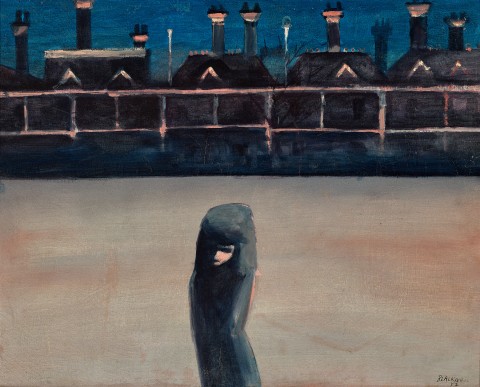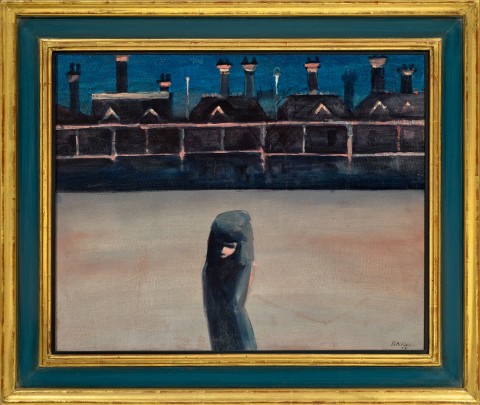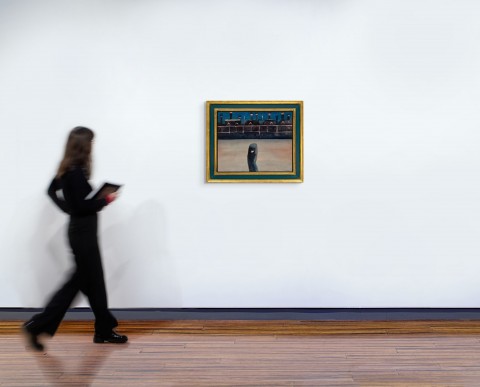(1928 - 2018)
Charles Blackman
Nocturne, 1952
oil and tempera on muslin on board
Savill Galleries, Sydney
Private collection, Melbourne, acquired from the above in 2002
A Century of Australian Painting 1888 – 1988, Savill Galleries, Sydney, 21 April – 21 May 1988, cat. 40
Arthur Boyd and Charles Blackman: Important Works, Savill Galleries, Sydney, 2 – 27 August 1989, cat. 19
Charles Blackman: Works from 1952 – 1990, Savill Galleries, Melbourne, 13 March – 21 April 2002 (label attached verso)
The Birthday, 1952, enamel on muslin gauze on composition board, 63.5 x 91.0 cm, private collection, illus. in Shapcott, T., The Art of Charles Blackman, Andre Deutsch, London, 1989, pl. 8
In the shadowy twilight, a lone girl drifts along a deserted suburban street enclosed by an anonymous row of terrace houses. An early poetic cityscape of lustrous tempera, Nocturne, 1952 was painted shortly after Charles Blackman and his wife, author Barbara, arrived in Melbourne, having recently settled in the suburb of Hawthorn. With symbolic simplification, Nocturne synthesises the artist’s subjective experience of isolation in an unfamiliar environment with the dominant currents of surrealist-tinged figuration and the palpable societal unease of the early 1950s. Describing a relationship between a vulnerable child and a hostile built environment, Nocturne emerges from the same ‘wellspring of creative courage’ that bore Blackman’s ‘Schoolgirls’ series, painted between 1952 - c.1954, definitively launching his emerging career.1
With an urgency and precocious authority that critic Alan McCulloch identified in his work as early as February 1952, Blackman’s cityscape paintings conveyed a psychological quality through ‘strong poetic bias.’2 The evocative imagery of poetry and literature, read aloud by Blackman to his visually impaired wife, provided endless aesthetic possibilities for the artist throughout his career. One of the earliest encounters came from a trip the Blackmans made in the winter of 1952 to Queensland. Here they stayed with poet Judith Wright, with whom Blackman discovered a shared appreciation of Australian lyric poet John Shaw Nielson – particularly his 1922 poem Schoolgirls Hastening. Parsing the differing versions of Blackman’s introduction to Nielson, it is likely that Sunday Reed first made the connection to the artist’s early cityscapes featuring children in the Hawthorn neighbourhood (such as Nocturne), and before his trip to Queensland referred him to the poem, which would become an influential touchstone for the later Schoolgirl paintings.3
Nocturne’s atmospheric scene, leached of colour, is isolated from a broader narrative like a still from a film noir. The landscape is stripped of superfluous detail to create instead a pattern of flat expanses of colour, against which the child seems to float, a central focal point. A bowed figure, her identity is concealed by clothes which become a rigid armour, at once protecting her from the nebulous threat presented by her built surroundings and detaching her from communication and interaction. Although she is partly illuminated, she casts no shadow across the empty street, her passive presence taking on an ambiguous and surreal quality. Different from the wide-eyed, knowing anxiety of the first of the Schoolgirls, this child is lost in reverie, seemingly unaware of the threats of the man-made landscape that provides her no shelter.
While his peer Danila Vasilieff had portrayed the children of Melbourne’s inner city streets as self-assured, with Blackman, their passive vulnerability is emphasised, set against the inhospitable angularity of Melbourne’s houses, factories and streets.4 Featuring saw-toothed gabled roofs, the tiered terraces enclosing this scene are half hidden in darkness; Blackman has rendered the genteel suburban environment strangely gothic. This same row of terraces is illuminated in more detail, as a backdrop to a centrally placed pair of figures, children holding hands, in a related work, The Birthday, 1952.
1. Amadio, N., Charles Blackman Lost Domains, Alpine Fine Arts Collection, New York, 1980, p. 10
2. McCulloch, A., ‘The Art of Charles Blackman’, Meanjin, vol. 11, no. 1, Autumn 1952, p. 44
3. Morgan, K., Charles Blackman: Schoolgirls, Heide Museum of Modern Art, Melbourne, pp. 12, 30
4. Dixon, C., and Smith, T., Aspects of Australian Figurative Painting 1942 – 62. Dreams, Fears and Desires, Power Institute of Fine Arts, University of Sydney, 1984, p. 80
LUCIE REEVES-SMITH


